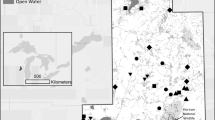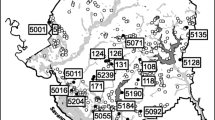Abstract
Since the late 1980s, the United States Fish and Wildlife Service (USFWS) has helped restore hundreds of wetlands in Manitowoc County, Wisconsin, in an effort to enhance the production of waterfowl and other wetland associated species. During summer 2004, we re-examined 11 restorations to determine how their plant communities had changed since 1992. In addition, we re-evaluated waterfowl and anuran communities at eight restorations. Because 1992 data were compiled from separate studies, all three groups of organisms were simultaneously examined at only two wetlands. Significant decreases in plant diversity and plant species richness were detected between 1992 and 2004, while significant increases were detected for species classified as obligate or facultative wet. These changes suggest that the plant communities at the restorations have matured since 1992. Use of the wetlands by waterfowl and anurans, on the other hand, did not exhibit significant change over this period. Regular monitoring of restorations over even longer periods will provide new insights into the way in which restored communities develop and whether current restoration methods have succeeded in establishing stable, species-rich wetland communities.
Similar content being viewed by others
Literature Cited
Adams, L. W., L. E. Dove, and T. M. Franklin. 1985. Mallard pair and brood use of urban stormwater-control impoundments. Wildlife Society Bulletin 13: 46–51.
Austin, J. E. 2002. Response of dabbling ducks to wetland conditions in the Prairie Pothole Region. Waterbirds 25: 465–73.
Bakker, J. D. and S. D. Wilson. 2004. Using ecological restoration to constrain biological invasion. Journal of Applied Ecology 41: 1058–64.
Batzer, D. P., R. Cooper, and S. A. Wissinger. 2006. Wetland animal ecology. p. 242–84. In D. P. Batzer and R. R. Sharitz (eds.) Ecology of Freshwater and Esturarine Wetlands. University of California Press, Berkeley, CA, USA.
Bernthal, T. W. 2003. Development of a floristic quality assessment methodology for Wisconsin. final report to the US Environmental Protection Agency, Region V. Wisconsin Department of Natural Resources, Madison, WI, USA.
Budelsky, R. A. and S. M. Galatowitsch. 2000. Effects of water regime and competition on the establishment of a native sedge in restored wetlands. Journal of Applied Ecology 37: 971–85.
Chadde, S. 1998. A Great Lakes Wetland Flora. PocketFlora Press, Calumet, MI, USA.
Cowardin, L. M., V. Carter, F. C. Golet, and E. T. LaRoe. 1979. Classification of Wetlands and Deepwater Habitats of the United States. US Department of Interior, Fish and Wildlife Service, Washington, DC, USA.
Curtis, J. T. 1959. The Vegetation of Wisconsin: An Ordination of Plant Communities. University of Wisconsin Press, Madison, WI, USA.
Cutright, N., B. Harriman, and R. Howe. 2006. The Atlas of Wisconsin Breeding Birds. Wisconsin Society for Ornithology, Waukesha, WI, USA.
Czarapata, E. J. 2005. Invasive Plants of the Upper Midwest. The University of Wisconsin Press, Madison, WI, USA.
Denk, D. D. 1997. Vegetation development and waterfowl use of restored versus natural wetlands. M.S. Thesis. University of Wisconsin-Stevens Point, Stevens Point, WI, USA.
Detenbeck, N. E., S. M. Galatowitsch, J. Atkinson, and H. Ball. 1999. Evaluating perturbations and developing restoration strategies for inland wetlands in the Great Lakes Basin. Wetlands 19: 789–820.
Ehrenfeld, J. G. 2000. Defining the limits of restoration: the need for realistic goals. Restoration Ecology 8: 2–9.
Federal Interagency Committee for Wetland Delineation. 1989. Federal manual for identifying and delineating jurisdictional wetlands. cooperative technical publication. US Army Corps of Engineers, US Environmental Protection Agency, US Fish and Wildlife Service, and USDA Soil Conservation Service, Washington, DC, USA.
Galatowitsch, S. M., R. Budelsky, and L. Yetka. 1999. Revegetation strategies for northern temperate glacial marshes and meadows. p. 225–41. In W. Streever (ed.) An International Perspective on Wetland Rehabilitation. Kluwer Academic, Dordrecht, Netherlands.
Galatowitsch, S. M. and A. G. van der Valk. 1996. The vegetation of restored and natural prairie wetlands. Ecological Applications 6: 102–12.
Genet, S. K. and L. G. Sargent. 2003. Evaluation of methods and data quality from a volunteer-based amphibian call survey. Wildlife Society Bulletin 31: 703–14.
Hine, R. L., B. L. Les, and B. F. Hellmich. 1981. Leopard frog populations and mortality in Wisconsin, 1974–1976. Technical Bulletin No. 122. Wisconsin Department of Natural Resources, Madison, WI, USA.
Jaspen, E. 1996. Biotic and abiotic monitoring and experimental restoration at a wetland mitigation site. M.S. Thesis. University of Wisconsin-Stevens Point, Stevens Point, WI, USA.
Joyner, D. E. 1980. Influence of invertebrates on pond selection by ducks in Ontario. Journal of Wildlife Management 44: 700–05.
Keddy, P. 2000. Wetland Ecology: Principles and Conservation. Cambridge University Press, New York, NY, USA.
Kitchens, L. J. 2003. Basic Statistics and Data Analysis. Brooks/ Cole, Pacific Grove, CA, USA.
Kolozsvary, M. B. and R. K. Swihart. 1999. Habitat fragmentation and the distribution of amphibians: patch and landscape correlates in Farmland. Canadian Journal of Zoology 77: 1288–99.
Lindig-Cisneros, R. and J. B. Zedler. 2002. Phalaris arundinacea seedling establishment: effects of canopy complexity in fen, mesocosm, and restoration experiments. Canadian Journal of Botany 80: 617–24.
Matthews, J. W., P. A. Tessene, S. M. Wiesbrook, and B. W. Zercher. 2005. Effect of area and isolation on species richness and indices of floristic quality in Illinois, USA wetlands. Wetlands 25: 607–15.
Mitsch, W. J. and J. G. Gosselink. 2000. Wetlands, third edition. John Wiley & Sons, Inc., New York, NY, USA.
Mitsch, W. J. and R. F. Wilson. 1996. Improving the success of wetland creation and restoration with know-how, time, and self-design. Ecological Applications 6: 77–83.
Mulhouse, J. M. and S. M. Galatowitsch. 2003. Revegetation of prairie pothole wetlands in the mid-continental US: twelve years post-reflooding. Plant Ecology 169: 143–59.
National Climatic Data Center. State of WI Rainfall. http:// lwf.ncdc.noaa.gov/oa/climate/research/cag3/WI.html. Last accessed 16 February 2005.
Nichols, S. A. 1999. Floristic quality assessment of Wisconsin lake plant communities with example applications. Journal of Lake and Reservoir Management 15: 133–41.
Odland, A. and R. del Moral. 2002. Thirteen years of wetland vegetation succession following a permanent drawdown, Myrkdalen Lake, Norway. Plant Ecology 162: 185–98.
Otter, A. J. 1980. Soil Survey of Manitowoc and Calumet Counties, Wisconsin. National Cooperative Soil Survey, USDA, Washington, DC, USA.
Perry, L. G., S. M. Galatowitsch, and C. J. Rosen. 2004. Competitive control of invasive vegetation: a native wetland sedge suppresses Phalaris arundinacea in carbon-enriched soil. Journal of Applied Ecology 41: 151–62.
Pough, F. H., R. M. Andrews, J. E. Cadle, M. L. Crump, A. H. Savitzky, and K. D. Wells. 1998. Herpetology. Prentice Hall, Upper Saddle River, NJ, USA.
Reinartz, J. A. and E. L. Warne. 1993. Development of vegetation in small created wetlands in southeastern Wisconsin. Wetlands 13: 153–64.
Robaidek, C. 1997. Macroinvertebrate and macrophyte communities of wetlands restored in Manitowoc County, WI. M.S. Thesis. University of Wisconsin-Green Bay, Green Bay, WI, USA.
Schuyt, K. and L. Brander. 2004. Living Waters — Conserving the Source of Life. The Economic Values of the World’s Wetlands. World Wide Fund for Nature, Gland, Amsterdam.
Schwar, M. T. 2002. Hydrologic restoration of a groundwater-fed sedge meadow wetland in south-central Wisconsin. Ph.D. Dissertation. University of Wisconsin, Madison, WI, USA.
Skelly, D. K., E. E. Werner, and S. A. Cortwright. 1999. Longterm distibutional dynamics of a Michigan amphibian assemblage. Ecology 80: 2326–37.
Sokal, R. R. and F. J. Rohlf. 1995. Biometry: The Principles and Practice of Statistics in Biological Research, third edition. Freeman, New York, NY, USA.
Stannard, M. and W. Crowder. 2001. Biology, History, and Supression of Reed Canarygrass (Phalaris arundinacea L). Technical Notes. NRCS, Spokane, WA, USA.
Trenham, P. C., W. D. Koenig, M. J. Mossman, S. L. Stark, and L. A. Jagger. 2003. Regional dynamics of wetland-breeding frogs and toads: turnover and synchrony. Ecological Applications 13: 1522–32.
Trochlell, P. and T. Bernthal. 1998. Small Wetlands and the Cumulative Impacts of Small Wetland Losses: A Synopsis of the Literature. WDNR, Madison, WI, USA.
USACE. 2006. Historic Great Lake Levels. http://www.lre. usace.army.mil/greatlakes/hh/greatlakeswaterlevels/historicdata/ greatlakeshydrographs. Last accessed 16 September 2006.
USDA. 2004. Plants Wetlands Database. http://plants.usda.gov/ cgi_bin/topics.cgi?earl=wetland.html. Last accessed 16 February 2005.
USFWS. 1998. Expanding the vision. 1998 update. North American Waterfowl Management Plan. US Department of Interior, Fish and Wildlife Service, Washington, DC, USA.
USFWS. 2000. Partners for Fish and Wildlife. Regional Highlights. Fiscal Year 2000. Great Lakes-Big Rivers Region. Bull. US Department of Interior, Fish and Wildlife Service, Washington, DC, USA.
USGS. 1998. Regional landscape ecosystems of Michigan, Minnesota, and Wisconsin. http://www.npwrc.usgs.gov/ resource/1998/rlandscp/wiscmap.html. Last accessed 23 May 2005.
University of Wisconsin Extension. 2004. Manitowoc County Agriculture: Value and Economic Impact. http://www.uwex. edu/ces/cty/manitowoc/documents/ManitowocAgImpact.pdf. Last accessed 26 October 2005.
van der Valk, A. G. 1981. Succession in wetlands: a Gleasonian approach. Ecology 62: 688–96.
VanRees-Siewert, K. L. and J. J. Dinsmore. 1996. Influence of wetland age on bird use of restored wetlands in Iowa. Wetlands 16: 577–82.
Voss, E. G. 1972. Michigan Flora, Part I. Cranbrook Institute of Science, Bloomfield Hills, MI, USA.
Voss, E. G. 1985. Michigan Flora, Part II. Cranbrook Institute of Science, Bloomfield Hills, MI, USA.
Voss, E. G. 1996. Michigan Flora, Part III. Cranbrook Institute of Science, Bloomfield Hills, MI, USA.
WDNR. 2000. Reversing the loss: a strategy for protecting and restoring wetlands in Wisconsin. Wisconsin Department of Natural Resources, Madison, WI, USA.
Wilhelm, G. S. and D. Ladd. 1988. Natural area assessment in the Chicago region. Transactions of the North American Wildlife and Natural Resources Conference 53: 361–75.
Williams, B. K., M. D. Koneff, and D. A. Smith. 1999. Evaluation of waterfowl conservation under the North American Waterfowl Management Plan. Journal of Wildlife Management 63: 417–40.
Yencha, A. 1993. Fauna and vegetation of restored wetlands in eastern Wisconsin. M.S. Thesis. University of Wisconsin-Green Bay, Green Bay, WI, USA.
Zedler, J. B. 2000. Progress in wetland restoration ecology. Ecology and Evolution 15: 402–07.
Zedler, J. B. and J. C. Callaway. 1999. Tracking wetland restoration: do mitigation sites follow desired trajectories? Restoration Ecology 7: 69–73.
Author information
Authors and Affiliations
Rights and permissions
About this article
Cite this article
Nedland, T.S., Wolf, A. & Reed, T. A reexamination of restored wetlands in Manitowoc County, Wisconsin. Wetlands 27, 999–1015 (2007). https://doi.org/10.1672/0277-5212(2007)27[999:ARORWI]2.0.CO;2
Received:
Accepted:
Issue Date:
DOI: https://doi.org/10.1672/0277-5212(2007)27[999:ARORWI]2.0.CO;2




